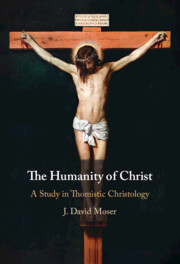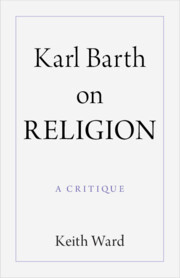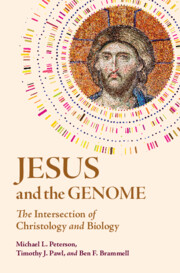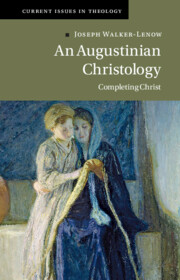Refine search
Actions for selected content:
76 results
7 - Theological Benefits of the Instrumental Doctrine
- from Part III - Theological Implications
-
- Book:
- The Humanity of Christ as Instrument of Salvation
- Published online:
- 21 August 2025
- Print publication:
- 04 September 2025, pp 201-225
-
- Chapter
- Export citation
Introduction
-
- Book:
- The Humanity of Christ as Instrument of Salvation
- Published online:
- 21 August 2025
- Print publication:
- 04 September 2025, pp 1-12
-
- Chapter
- Export citation

The Humanity of Christ as Instrument of Salvation
- A Study in Thomistic Christology
-
- Published online:
- 21 August 2025
- Print publication:
- 04 September 2025
105 - Annianus of Alexandria, Chronography
-
- Book:
- The Fragmentary Greek Chronicles after Eusebius
- Published online:
- 11 September 2025
- Print publication:
- 24 July 2025, pp 215-309
-
- Chapter
- Export citation
11 - Preaching on the Totus Christus
- from Part III - Augustine’s Preaching Themes
-
-
- Book:
- The Cambridge Companion to Augustine's Sermons
- Published online:
- 26 May 2025
- Print publication:
- 12 June 2025, pp 209-225
-
- Chapter
- Export citation
Towards a grammar of theocentric belonging: Kilby, Tanner and beyond
-
- Journal:
- Scottish Journal of Theology , First View
- Published online by Cambridge University Press:
- 06 March 2025, pp. 1-11
-
- Article
- Export citation
4 - Orthodox Foundations
- from Part II - An Emerging Story
-
- Book:
- Constructing an Incarnational Theology
- Published online:
- 09 January 2025
- Print publication:
- 23 January 2025, pp 87-113
-
- Chapter
- Export citation
1 - An Incarnational Theology
- from Part I - The Story of God
-
- Book:
- Constructing an Incarnational Theology
- Published online:
- 09 January 2025
- Print publication:
- 23 January 2025, pp 9-23
-
- Chapter
- Export citation
8 - God’s Purpose
- from Part III - Reconfiguring the Story
-
- Book:
- Constructing an Incarnational Theology
- Published online:
- 09 January 2025
- Print publication:
- 23 January 2025, pp 188-215
-
- Chapter
- Export citation
10 - Constructive Approaches to the Historical Reality of Physicalism
-
- Book:
- Human Salvation in Early Christianity
- Published online:
- 09 January 2025
- Print publication:
- 23 January 2025, pp 289-306
-
- Chapter
- Export citation
God Did Not Choose to Save the World by Talk: E.L. Mascall on the Incarnation and Its Consequences
-
- Journal:
- Journal of Anglican Studies / Volume 22 / Issue 2 / November 2024
- Published online by Cambridge University Press:
- 13 January 2025, pp. 542-557
-
- Article
- Export citation
22 - The Future of Jesus of Nazareth
- from Part V - Outlook
-
-
- Book:
- The New Cambridge Companion to Jesus
- Published online:
- 15 November 2024
- Print publication:
- 05 December 2024, pp 365-378
-
- Chapter
- Export citation
14 - The Body of Jesus in His People
- from Part III - Ethics, Theology, and Critical Scholarship
-
-
- Book:
- The New Cambridge Companion to Jesus
- Published online:
- 15 November 2024
- Print publication:
- 05 December 2024, pp 232-249
-
- Chapter
- Export citation
6 - Jesus and the Triune God
- from Part I - Origins
-
-
- Book:
- The New Cambridge Companion to Jesus
- Published online:
- 15 November 2024
- Print publication:
- 05 December 2024, pp 88-102
-
- Chapter
- Export citation

Karl Barth on Religion
- A Critique
-
- Published online:
- 14 November 2024
- Print publication:
- 21 November 2024

Jesus and the Genome
- The Intersection of Christology and Biology
-
- Published online:
- 07 November 2024
- Print publication:
- 28 November 2024
Chapter 6 - Deification as Intimacy with God in the Bible
-
- Book:
- Deification in Classical Greek Philosophy and the Bible
- Published online:
- 10 July 2024
- Print publication:
- 27 June 2024, pp 267-304
-
- Chapter
- Export citation
Introduction
-
- Book:
- An Augustinian Christology
- Published online:
- 02 November 2023
- Print publication:
- 16 November 2023, pp 1-34
-
- Chapter
- Export citation
2 - The Human Life of God
- from Part I - The Divine-Human Life
-
- Book:
- An Augustinian Christology
- Published online:
- 02 November 2023
- Print publication:
- 16 November 2023, pp 72-110
-
- Chapter
- Export citation

An Augustinian Christology
- Completing Christ
-
- Published online:
- 02 November 2023
- Print publication:
- 16 November 2023
